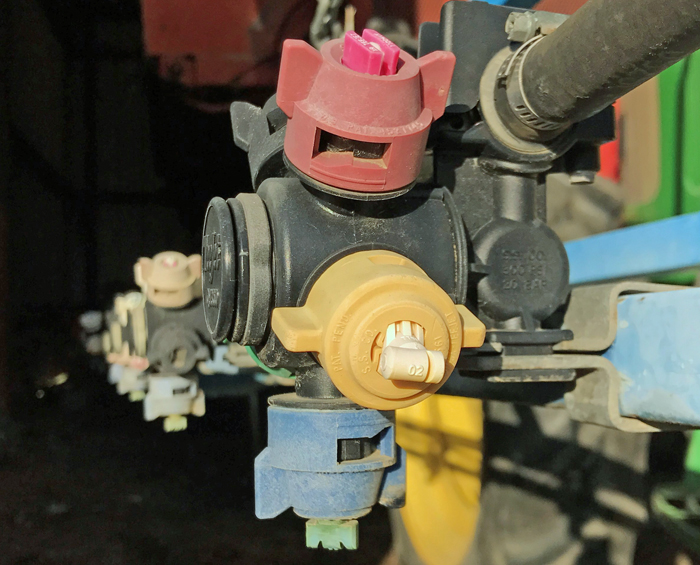
Over time spray nozzles wear with use, resulting in rate and application changes that can increase your spray costs. Photo Credit: Ian Small
Ian Small, UF/IFAS Plant Pathologist, NFREC Quincy, and Jeff Clack, Hypro Pentair Flow Technologies
There is no shortage of new technologies being marketed to improve the efficiency of farming operations. The most cost effective place to start is with the basics, or in other words, start with the parts of your operation that improve efficiency for the least effort and cost! As a colleague of mine likes to say, “Consider the pain for the gain.” As we approach the 2017 growing season, it is essential to keep in mind one of the fundamentals of pesticide application – sprayer nozzle selection. Proper selection of nozzle type and size is essential for correct pesticide application.
There are several types of nozzles available on the market (flat fan, extended range, high flow, low drift, etc) that have been developed for specific applications. It is important to select the appropriate nozzle type and size for each type of application you intend to make. Consider the type of spraying you are planning to do: broadcast, banded/directed, boomless, or boom extender. For example, if you are broadcast spraying you will need to consider your nozzle tip spacing, speed during application, target application rate, solution density, and target droplet size when selecting a nozzle type. After installation of new nozzles be sure to calibrate your sprayer to verify that all nozzles are functioning correctly and that the target application rate is being achieved. For a step-by-step guide to calibration utilize the link to this publication: Calibration of Pesticide Applicators: Boom Sprayers.
There are several online nozzle selection tools to help ensure that you are selecting the appropriate nozzle for your application. Here are two examples of these tools:
-
John Deere Nozzle Selector (interactive webpage)
-
Teejet SpraySelect Tip Selection (App for smart phones)
Although these tools are freely available, it is still your responsibility to verify that you will be able to adhere to label precautions, or state and federal laws relating to appropriate nozzle type and associated application pressures. In certain applications, drift reduction is very important! See the following guide to spray drift reduction Managing Pesticide Drift and the recent article on managing dicamba drift Managing Dicamba Drift when using New Dicamba Resistant Cotton Varieties.
Nozzles do wear with use, resulting in incorrect flow rates and application patterns. If your flow rate and application pattern are incorrect this will result in less effective sprays, as well as increased spray costs. Certain nozzle materials will wear faster than others and applying certain abrasive pesticide formulations will accelerate this process.
To detect nozzle wear:
- Check the flow rate. To check the flow rate of your current nozzles, conduct a boom sprayer nozzle performance test Boom Sprayer Nozzle Performance Test.
- Visually check the spray pattern.
- Check the spray coverage. Nozzle wear or poor alignment will reduce the uniformity of coverage.
- Inspect the spray pressure and volume. If using centrifugal pumps, monitor for increases in liquid volume sprayed. If using positive displacement pumps, monitor for pressure decreases.
Poor sprayer calibration is an often-overlooked culprit behind misapplication. Simply checking each nozzle to ensure that proper flow rate is being attained can help identify problems. If using nozzles with screens, routine cleaning of screens associated with each nozzle can often solve flow rate problems on nozzles that are not worn. A spray nozzle can be considered out of calibration tolerance if its flow rate is 10% greater than its rated flow. All agricultural nozzles are rated for flow at 40 PSI and color coded as such. A red nozzle for example represents an “04” size. This equates to 0.4 GPM at 40 PSI. If the nozzle is calibrated and its flow rate is 0.44 GPM or greater it should be replaced.
Boom section management is also an area that deserves attention. Many growers express concern that certain nozzles on their booms do not shut off immediately when deactivated. This is often due to air in the booms and hoses. If pressure is applied to a system that contains air in the liquid line, the air then becomes compressed. When the boom is shut off, the air decompresses and holds the check valves open and the nozzles continue to spray or drip until the air is depressurized. The addition of aspirators to the boom will eliminate this problem, and enable a more rapid response to boom controls.
Lastly, be sure to clean all spray equipment after use. Sprayer hygiene is of utmost importance. Regardless of sprayer type, the proper sanitation of the unit greatly reduces unintended injury to targeted and neighboring fields. Commercial rinsing and cleaning formulations are available to help neutralize residual chemicals, and enhance sanitation when going from one crop to the other using materials that can damage the next crop if not properly rinsed.
By selecting and maintaining the correct nozzles, calibrating and cleaning your sprayer, and adhering to appropriate application techniques you can help ensure the sustainability of your farming operation, and prevent unintended consequences from poor application techniques.
Additional information on this topic is available utilizing the following links:
-
Calibration of Chemical Applicators Used in Vegetables
-
Managing Pesticide Drift
-
Boom Sprayer Nozzle Performance Test
-
Broadcast Boom Sprayer Calibration
-
Calibration of Herbicide Applicators
-
Five Tips to Reduce Pesticide Spray Drift
-
Calibration of Pesticide Applicators: Boom Sprayers
-
Teejet Tips for Nozzle Maintenance
-
Machine Finder Guide to John Deere Sprayer Nozzles
- Managing Peanut Health and Diseases in the Winter - January 31, 2025
- Bridging the Gap: Empowering Youth with Ag-Tech Skills - July 16, 2024
- Time to Protect your Cotton from Premature Defoliation due to Foliar Diseases - July 30, 2021
